Analysis of 2019-20 Federal Budget
VerifiedAdded on 2023/01/04
|7
|1574
|78
AI Summary
This document provides an analysis of the 2019-20 federal budget, focusing on its aim to return the Australian economy to budget surplus. It discusses the tax policy, its impact on lower income individuals and small businesses, and the winners and losers of the policy. The document also explores the implications for accounting firms and the compliance procedures related to the tax reforms. References are provided for further reading.
Contribute Materials
Your contribution can guide someone’s learning journey. Share your
documents today.
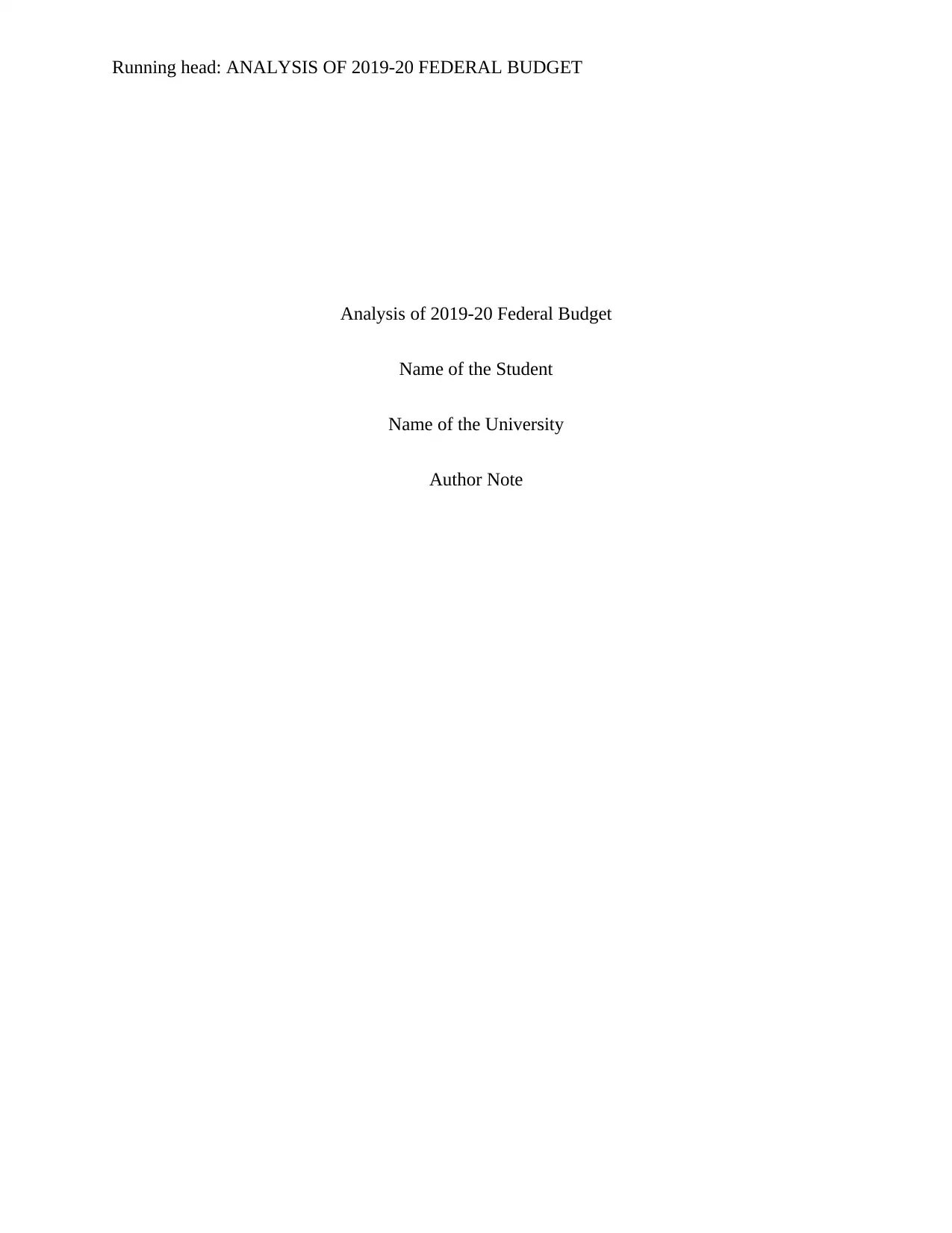
Running head: ANALYSIS OF 2019-20 FEDERAL BUDGET
Analysis of 2019-20 Federal Budget
Name of the Student
Name of the University
Author Note
Analysis of 2019-20 Federal Budget
Name of the Student
Name of the University
Author Note
Secure Best Marks with AI Grader
Need help grading? Try our AI Grader for instant feedback on your assignments.
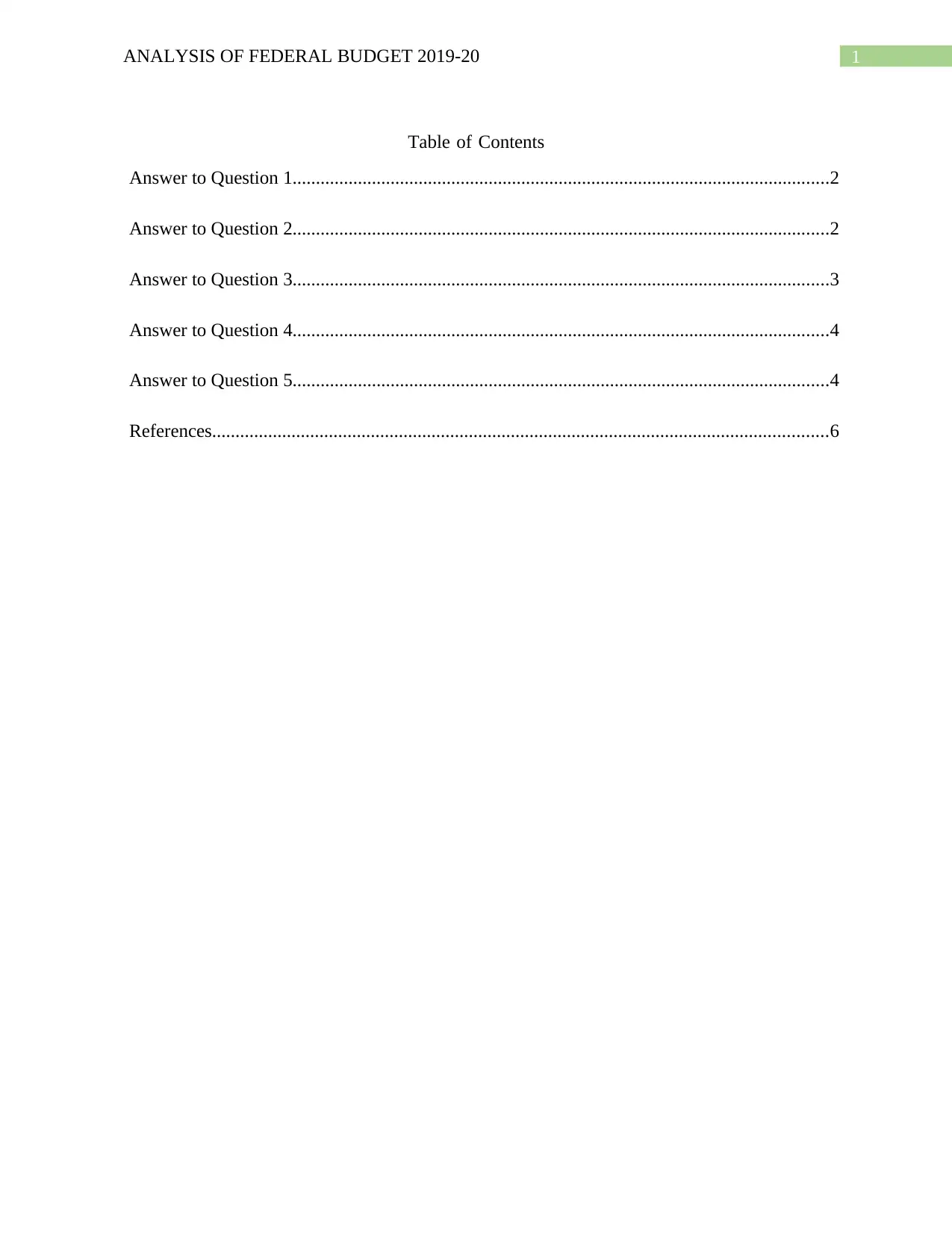
1ANALYSIS OF FEDERAL BUDGET 2019-20
Table of Contents
Answer to Question 1...................................................................................................................2
Answer to Question 2...................................................................................................................2
Answer to Question 3...................................................................................................................3
Answer to Question 4...................................................................................................................4
Answer to Question 5...................................................................................................................4
References....................................................................................................................................6
Table of Contents
Answer to Question 1...................................................................................................................2
Answer to Question 2...................................................................................................................2
Answer to Question 3...................................................................................................................3
Answer to Question 4...................................................................................................................4
Answer to Question 5...................................................................................................................4
References....................................................................................................................................6
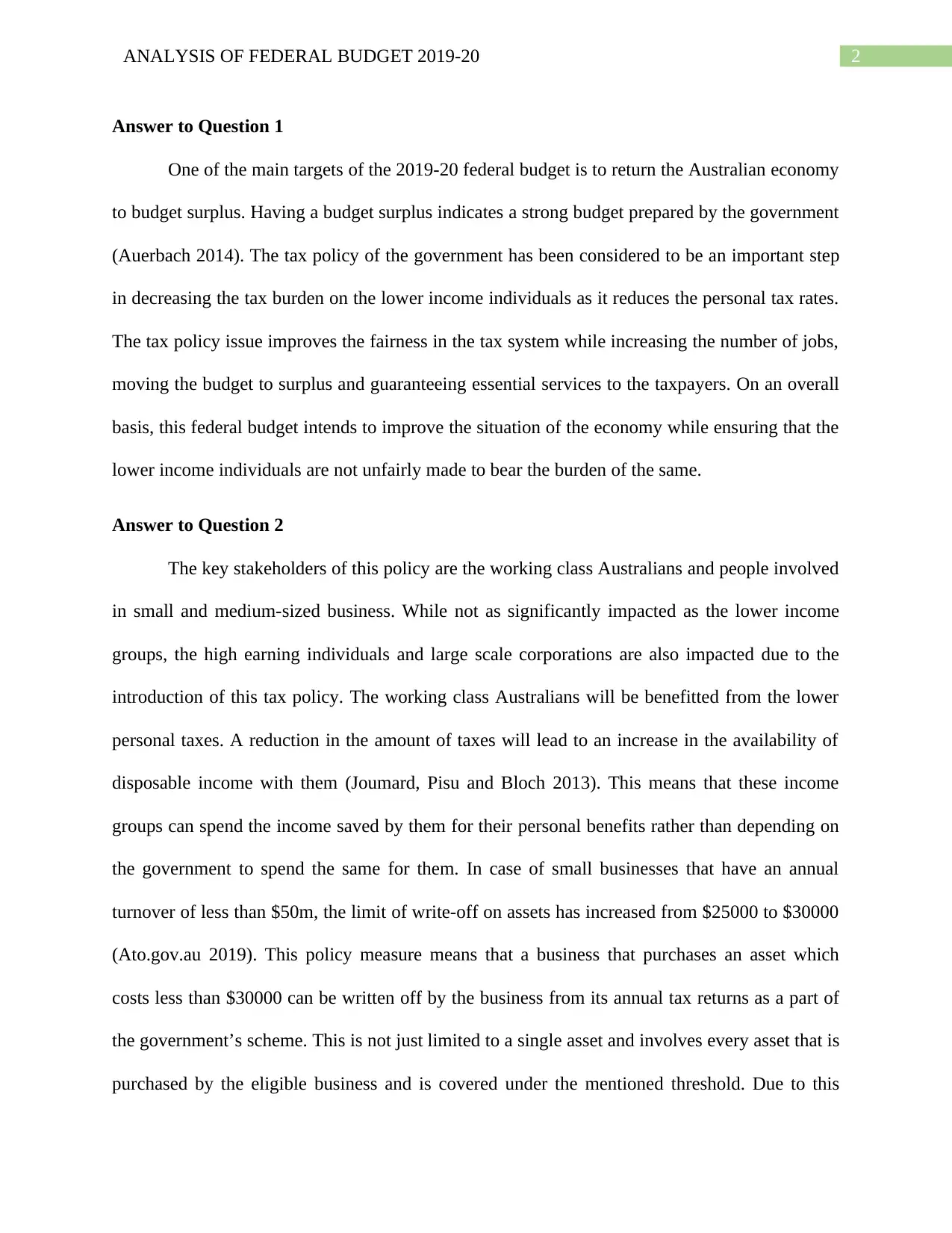
2ANALYSIS OF FEDERAL BUDGET 2019-20
Answer to Question 1
One of the main targets of the 2019-20 federal budget is to return the Australian economy
to budget surplus. Having a budget surplus indicates a strong budget prepared by the government
(Auerbach 2014). The tax policy of the government has been considered to be an important step
in decreasing the tax burden on the lower income individuals as it reduces the personal tax rates.
The tax policy issue improves the fairness in the tax system while increasing the number of jobs,
moving the budget to surplus and guaranteeing essential services to the taxpayers. On an overall
basis, this federal budget intends to improve the situation of the economy while ensuring that the
lower income individuals are not unfairly made to bear the burden of the same.
Answer to Question 2
The key stakeholders of this policy are the working class Australians and people involved
in small and medium-sized business. While not as significantly impacted as the lower income
groups, the high earning individuals and large scale corporations are also impacted due to the
introduction of this tax policy. The working class Australians will be benefitted from the lower
personal taxes. A reduction in the amount of taxes will lead to an increase in the availability of
disposable income with them (Joumard, Pisu and Bloch 2013). This means that these income
groups can spend the income saved by them for their personal benefits rather than depending on
the government to spend the same for them. In case of small businesses that have an annual
turnover of less than $50m, the limit of write-off on assets has increased from $25000 to $30000
(Ato.gov.au 2019). This policy measure means that a business that purchases an asset which
costs less than $30000 can be written off by the business from its annual tax returns as a part of
the government’s scheme. This is not just limited to a single asset and involves every asset that is
purchased by the eligible business and is covered under the mentioned threshold. Due to this
Answer to Question 1
One of the main targets of the 2019-20 federal budget is to return the Australian economy
to budget surplus. Having a budget surplus indicates a strong budget prepared by the government
(Auerbach 2014). The tax policy of the government has been considered to be an important step
in decreasing the tax burden on the lower income individuals as it reduces the personal tax rates.
The tax policy issue improves the fairness in the tax system while increasing the number of jobs,
moving the budget to surplus and guaranteeing essential services to the taxpayers. On an overall
basis, this federal budget intends to improve the situation of the economy while ensuring that the
lower income individuals are not unfairly made to bear the burden of the same.
Answer to Question 2
The key stakeholders of this policy are the working class Australians and people involved
in small and medium-sized business. While not as significantly impacted as the lower income
groups, the high earning individuals and large scale corporations are also impacted due to the
introduction of this tax policy. The working class Australians will be benefitted from the lower
personal taxes. A reduction in the amount of taxes will lead to an increase in the availability of
disposable income with them (Joumard, Pisu and Bloch 2013). This means that these income
groups can spend the income saved by them for their personal benefits rather than depending on
the government to spend the same for them. In case of small businesses that have an annual
turnover of less than $50m, the limit of write-off on assets has increased from $25000 to $30000
(Ato.gov.au 2019). This policy measure means that a business that purchases an asset which
costs less than $30000 can be written off by the business from its annual tax returns as a part of
the government’s scheme. This is not just limited to a single asset and involves every asset that is
purchased by the eligible business and is covered under the mentioned threshold. Due to this
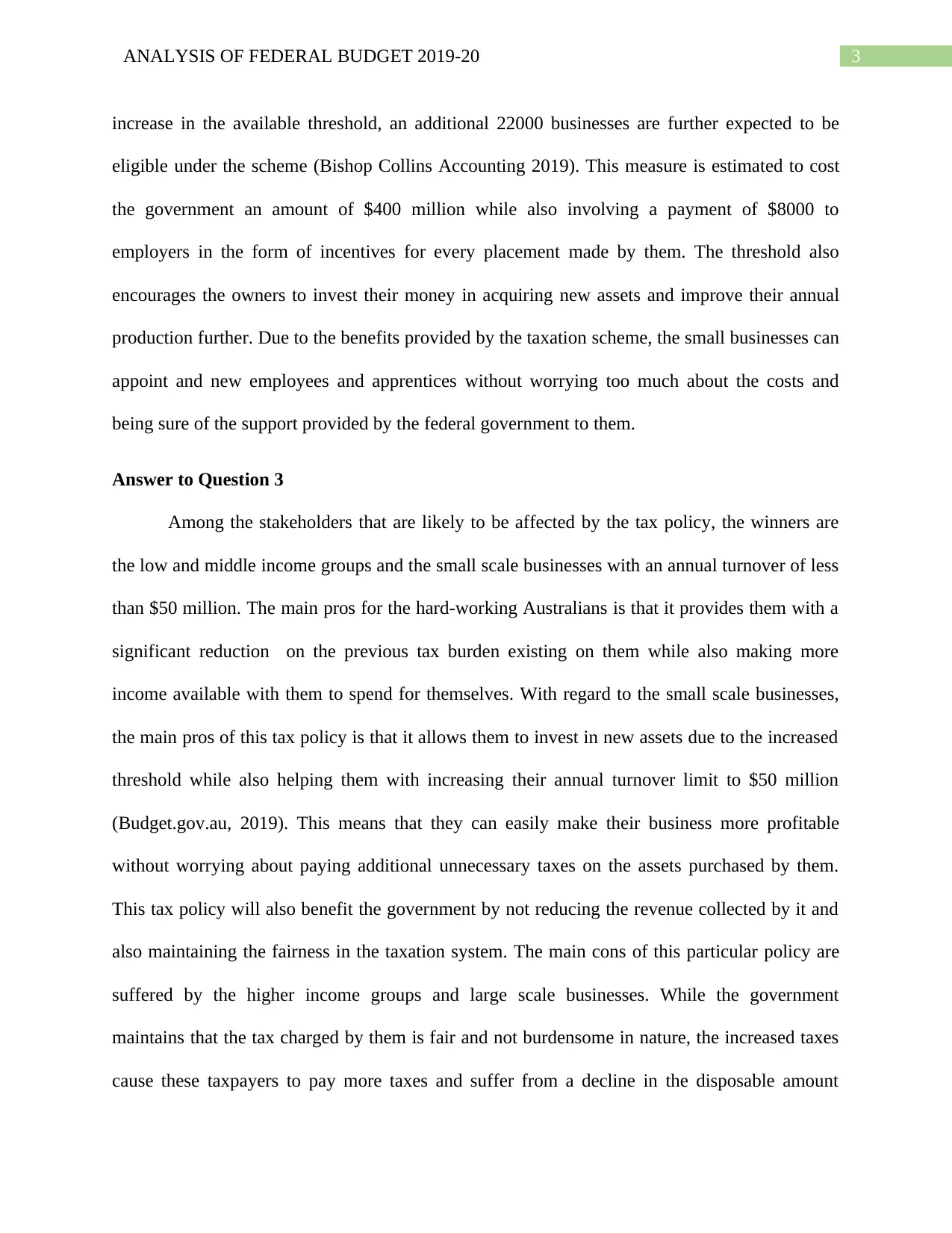
3ANALYSIS OF FEDERAL BUDGET 2019-20
increase in the available threshold, an additional 22000 businesses are further expected to be
eligible under the scheme (Bishop Collins Accounting 2019). This measure is estimated to cost
the government an amount of $400 million while also involving a payment of $8000 to
employers in the form of incentives for every placement made by them. The threshold also
encourages the owners to invest their money in acquiring new assets and improve their annual
production further. Due to the benefits provided by the taxation scheme, the small businesses can
appoint and new employees and apprentices without worrying too much about the costs and
being sure of the support provided by the federal government to them.
Answer to Question 3
Among the stakeholders that are likely to be affected by the tax policy, the winners are
the low and middle income groups and the small scale businesses with an annual turnover of less
than $50 million. The main pros for the hard-working Australians is that it provides them with a
significant reduction on the previous tax burden existing on them while also making more
income available with them to spend for themselves. With regard to the small scale businesses,
the main pros of this tax policy is that it allows them to invest in new assets due to the increased
threshold while also helping them with increasing their annual turnover limit to $50 million
(Budget.gov.au, 2019). This means that they can easily make their business more profitable
without worrying about paying additional unnecessary taxes on the assets purchased by them.
This tax policy will also benefit the government by not reducing the revenue collected by it and
also maintaining the fairness in the taxation system. The main cons of this particular policy are
suffered by the higher income groups and large scale businesses. While the government
maintains that the tax charged by them is fair and not burdensome in nature, the increased taxes
cause these taxpayers to pay more taxes and suffer from a decline in the disposable amount
increase in the available threshold, an additional 22000 businesses are further expected to be
eligible under the scheme (Bishop Collins Accounting 2019). This measure is estimated to cost
the government an amount of $400 million while also involving a payment of $8000 to
employers in the form of incentives for every placement made by them. The threshold also
encourages the owners to invest their money in acquiring new assets and improve their annual
production further. Due to the benefits provided by the taxation scheme, the small businesses can
appoint and new employees and apprentices without worrying too much about the costs and
being sure of the support provided by the federal government to them.
Answer to Question 3
Among the stakeholders that are likely to be affected by the tax policy, the winners are
the low and middle income groups and the small scale businesses with an annual turnover of less
than $50 million. The main pros for the hard-working Australians is that it provides them with a
significant reduction on the previous tax burden existing on them while also making more
income available with them to spend for themselves. With regard to the small scale businesses,
the main pros of this tax policy is that it allows them to invest in new assets due to the increased
threshold while also helping them with increasing their annual turnover limit to $50 million
(Budget.gov.au, 2019). This means that they can easily make their business more profitable
without worrying about paying additional unnecessary taxes on the assets purchased by them.
This tax policy will also benefit the government by not reducing the revenue collected by it and
also maintaining the fairness in the taxation system. The main cons of this particular policy are
suffered by the higher income groups and large scale businesses. While the government
maintains that the tax charged by them is fair and not burdensome in nature, the increased taxes
cause these taxpayers to pay more taxes and suffer from a decline in the disposable amount
Secure Best Marks with AI Grader
Need help grading? Try our AI Grader for instant feedback on your assignments.
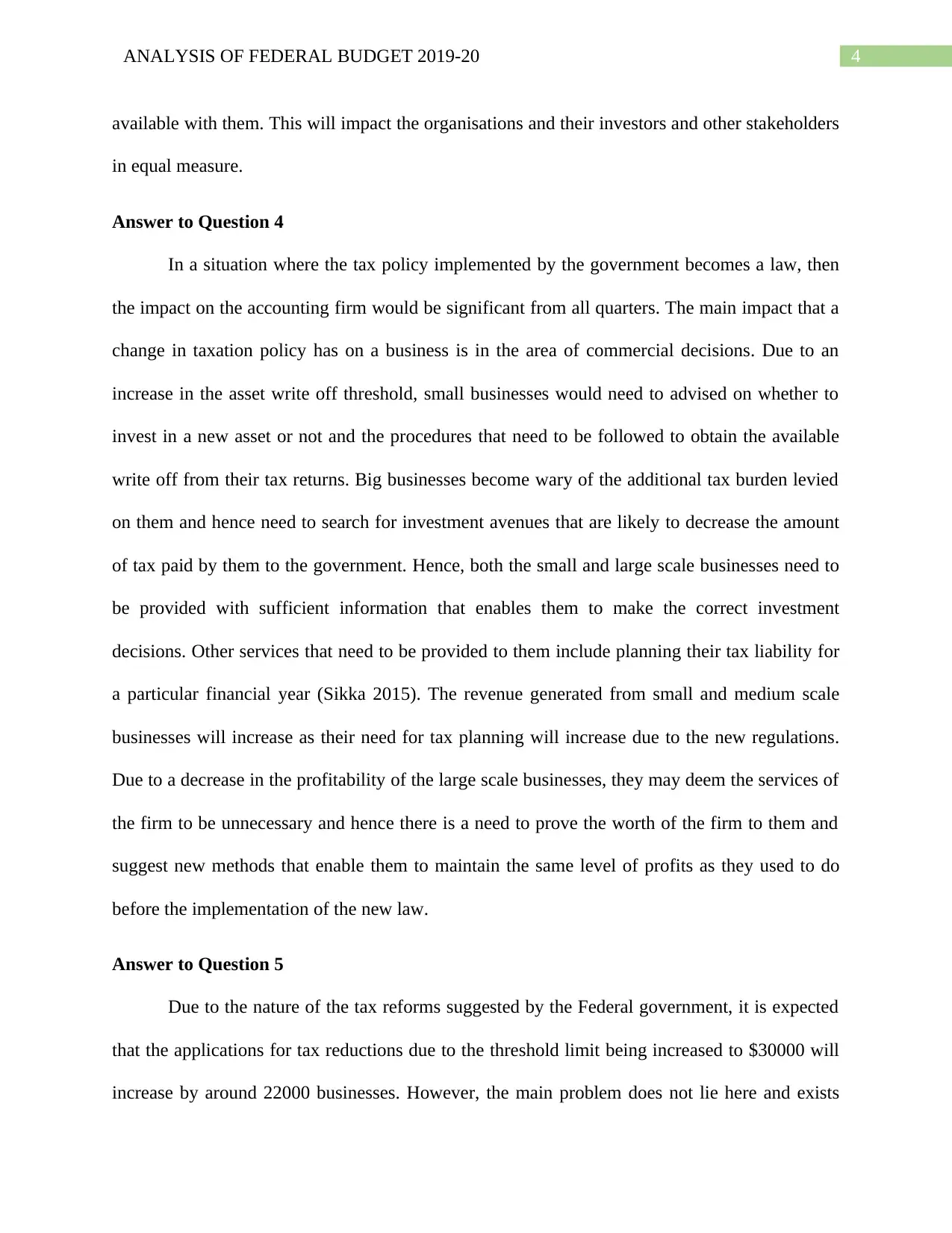
4ANALYSIS OF FEDERAL BUDGET 2019-20
available with them. This will impact the organisations and their investors and other stakeholders
in equal measure.
Answer to Question 4
In a situation where the tax policy implemented by the government becomes a law, then
the impact on the accounting firm would be significant from all quarters. The main impact that a
change in taxation policy has on a business is in the area of commercial decisions. Due to an
increase in the asset write off threshold, small businesses would need to advised on whether to
invest in a new asset or not and the procedures that need to be followed to obtain the available
write off from their tax returns. Big businesses become wary of the additional tax burden levied
on them and hence need to search for investment avenues that are likely to decrease the amount
of tax paid by them to the government. Hence, both the small and large scale businesses need to
be provided with sufficient information that enables them to make the correct investment
decisions. Other services that need to be provided to them include planning their tax liability for
a particular financial year (Sikka 2015). The revenue generated from small and medium scale
businesses will increase as their need for tax planning will increase due to the new regulations.
Due to a decrease in the profitability of the large scale businesses, they may deem the services of
the firm to be unnecessary and hence there is a need to prove the worth of the firm to them and
suggest new methods that enable them to maintain the same level of profits as they used to do
before the implementation of the new law.
Answer to Question 5
Due to the nature of the tax reforms suggested by the Federal government, it is expected
that the applications for tax reductions due to the threshold limit being increased to $30000 will
increase by around 22000 businesses. However, the main problem does not lie here and exists
available with them. This will impact the organisations and their investors and other stakeholders
in equal measure.
Answer to Question 4
In a situation where the tax policy implemented by the government becomes a law, then
the impact on the accounting firm would be significant from all quarters. The main impact that a
change in taxation policy has on a business is in the area of commercial decisions. Due to an
increase in the asset write off threshold, small businesses would need to advised on whether to
invest in a new asset or not and the procedures that need to be followed to obtain the available
write off from their tax returns. Big businesses become wary of the additional tax burden levied
on them and hence need to search for investment avenues that are likely to decrease the amount
of tax paid by them to the government. Hence, both the small and large scale businesses need to
be provided with sufficient information that enables them to make the correct investment
decisions. Other services that need to be provided to them include planning their tax liability for
a particular financial year (Sikka 2015). The revenue generated from small and medium scale
businesses will increase as their need for tax planning will increase due to the new regulations.
Due to a decrease in the profitability of the large scale businesses, they may deem the services of
the firm to be unnecessary and hence there is a need to prove the worth of the firm to them and
suggest new methods that enable them to maintain the same level of profits as they used to do
before the implementation of the new law.
Answer to Question 5
Due to the nature of the tax reforms suggested by the Federal government, it is expected
that the applications for tax reductions due to the threshold limit being increased to $30000 will
increase by around 22000 businesses. However, the main problem does not lie here and exists
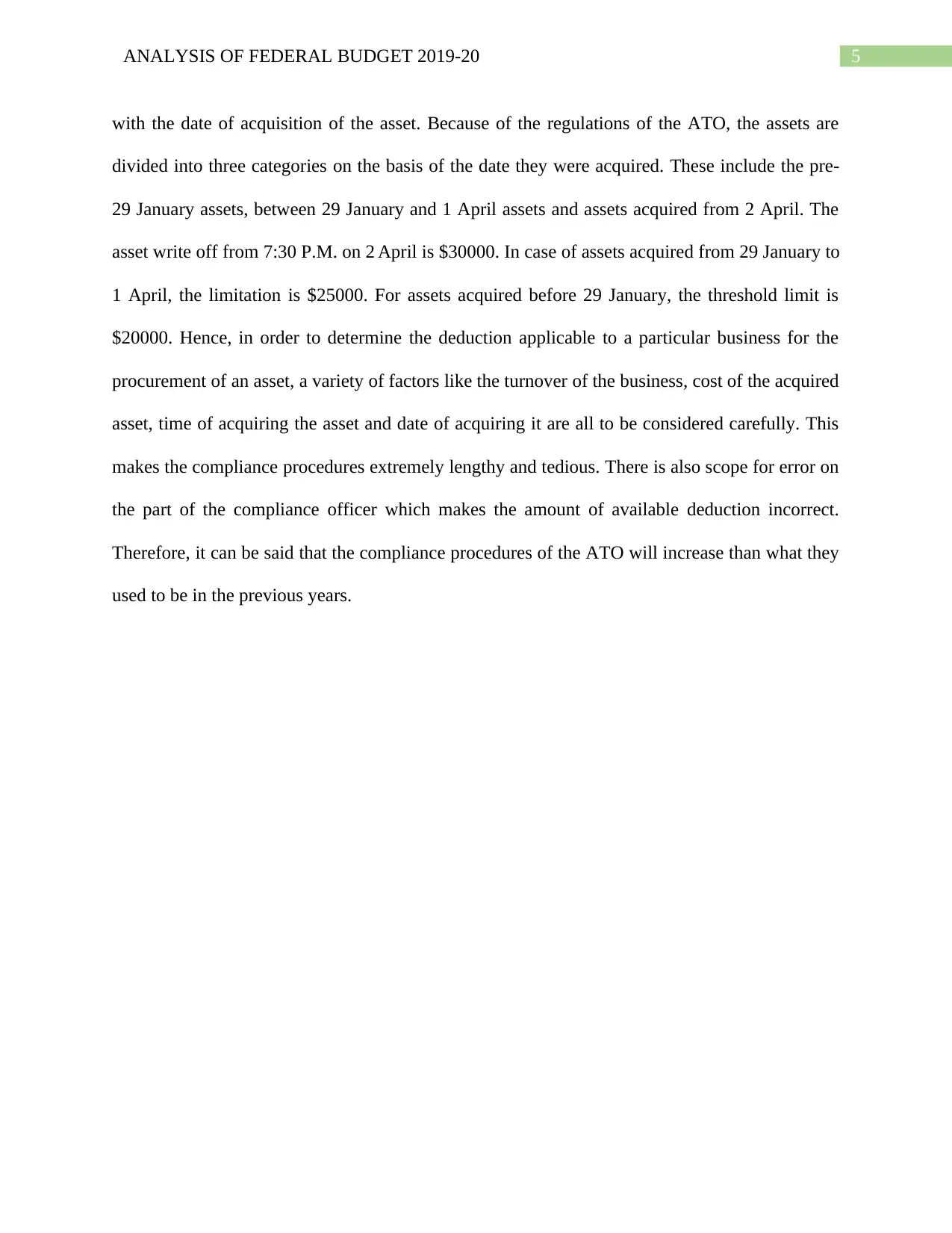
5ANALYSIS OF FEDERAL BUDGET 2019-20
with the date of acquisition of the asset. Because of the regulations of the ATO, the assets are
divided into three categories on the basis of the date they were acquired. These include the pre-
29 January assets, between 29 January and 1 April assets and assets acquired from 2 April. The
asset write off from 7:30 P.M. on 2 April is $30000. In case of assets acquired from 29 January to
1 April, the limitation is $25000. For assets acquired before 29 January, the threshold limit is
$20000. Hence, in order to determine the deduction applicable to a particular business for the
procurement of an asset, a variety of factors like the turnover of the business, cost of the acquired
asset, time of acquiring the asset and date of acquiring it are all to be considered carefully. This
makes the compliance procedures extremely lengthy and tedious. There is also scope for error on
the part of the compliance officer which makes the amount of available deduction incorrect.
Therefore, it can be said that the compliance procedures of the ATO will increase than what they
used to be in the previous years.
with the date of acquisition of the asset. Because of the regulations of the ATO, the assets are
divided into three categories on the basis of the date they were acquired. These include the pre-
29 January assets, between 29 January and 1 April assets and assets acquired from 2 April. The
asset write off from 7:30 P.M. on 2 April is $30000. In case of assets acquired from 29 January to
1 April, the limitation is $25000. For assets acquired before 29 January, the threshold limit is
$20000. Hence, in order to determine the deduction applicable to a particular business for the
procurement of an asset, a variety of factors like the turnover of the business, cost of the acquired
asset, time of acquiring the asset and date of acquiring it are all to be considered carefully. This
makes the compliance procedures extremely lengthy and tedious. There is also scope for error on
the part of the compliance officer which makes the amount of available deduction incorrect.
Therefore, it can be said that the compliance procedures of the ATO will increase than what they
used to be in the previous years.
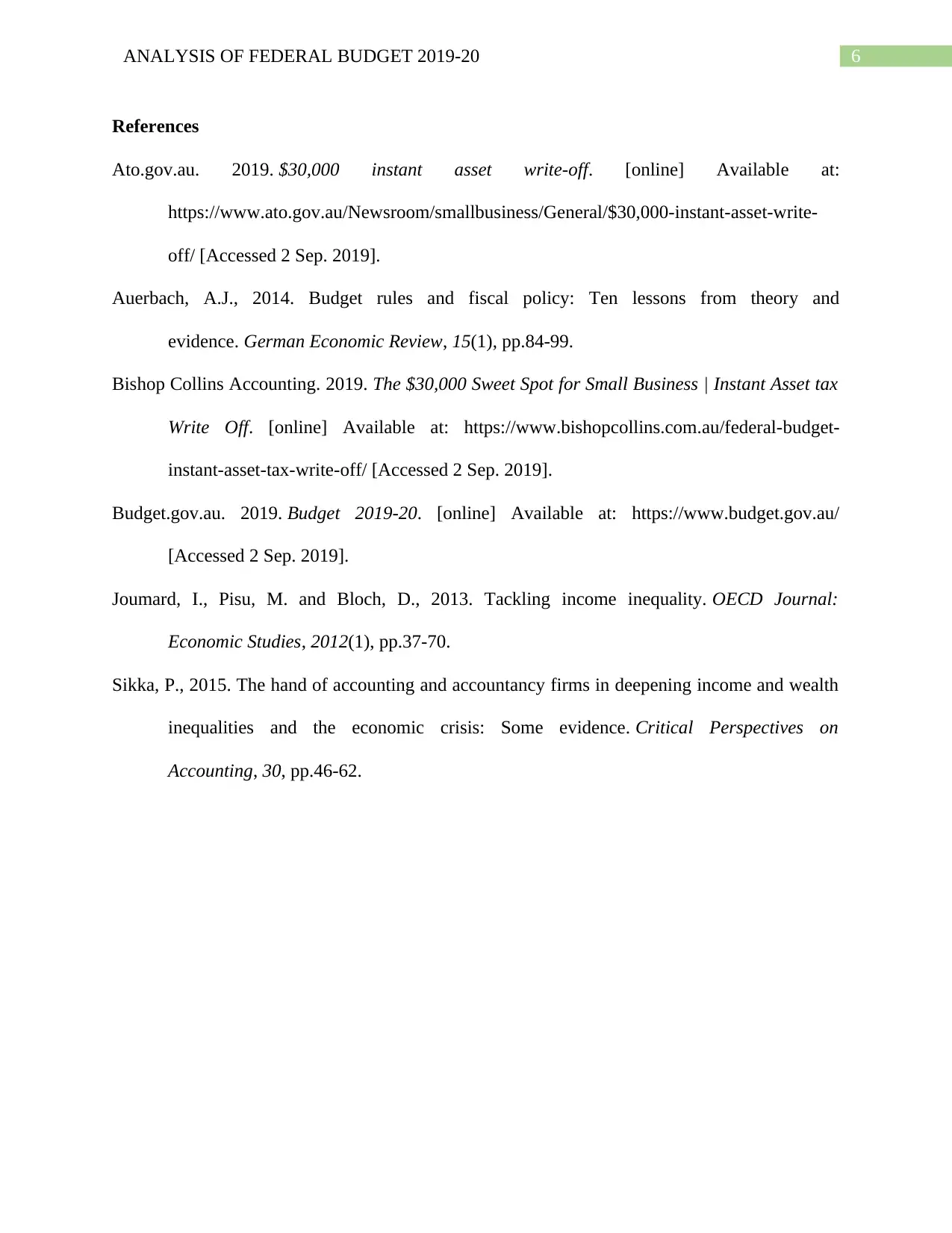
6ANALYSIS OF FEDERAL BUDGET 2019-20
References
Ato.gov.au. 2019. $30,000 instant asset write-off. [online] Available at:
https://www.ato.gov.au/Newsroom/smallbusiness/General/$30,000-instant-asset-write-
off/ [Accessed 2 Sep. 2019].
Auerbach, A.J., 2014. Budget rules and fiscal policy: Ten lessons from theory and
evidence. German Economic Review, 15(1), pp.84-99.
Bishop Collins Accounting. 2019. The $30,000 Sweet Spot for Small Business | Instant Asset tax
Write Off. [online] Available at: https://www.bishopcollins.com.au/federal-budget-
instant-asset-tax-write-off/ [Accessed 2 Sep. 2019].
Budget.gov.au. 2019. Budget 2019-20. [online] Available at: https://www.budget.gov.au/
[Accessed 2 Sep. 2019].
Joumard, I., Pisu, M. and Bloch, D., 2013. Tackling income inequality. OECD Journal:
Economic Studies, 2012(1), pp.37-70.
Sikka, P., 2015. The hand of accounting and accountancy firms in deepening income and wealth
inequalities and the economic crisis: Some evidence. Critical Perspectives on
Accounting, 30, pp.46-62.
References
Ato.gov.au. 2019. $30,000 instant asset write-off. [online] Available at:
https://www.ato.gov.au/Newsroom/smallbusiness/General/$30,000-instant-asset-write-
off/ [Accessed 2 Sep. 2019].
Auerbach, A.J., 2014. Budget rules and fiscal policy: Ten lessons from theory and
evidence. German Economic Review, 15(1), pp.84-99.
Bishop Collins Accounting. 2019. The $30,000 Sweet Spot for Small Business | Instant Asset tax
Write Off. [online] Available at: https://www.bishopcollins.com.au/federal-budget-
instant-asset-tax-write-off/ [Accessed 2 Sep. 2019].
Budget.gov.au. 2019. Budget 2019-20. [online] Available at: https://www.budget.gov.au/
[Accessed 2 Sep. 2019].
Joumard, I., Pisu, M. and Bloch, D., 2013. Tackling income inequality. OECD Journal:
Economic Studies, 2012(1), pp.37-70.
Sikka, P., 2015. The hand of accounting and accountancy firms in deepening income and wealth
inequalities and the economic crisis: Some evidence. Critical Perspectives on
Accounting, 30, pp.46-62.
1 out of 7
Your All-in-One AI-Powered Toolkit for Academic Success.
+13062052269
info@desklib.com
Available 24*7 on WhatsApp / Email
![[object Object]](/_next/static/media/star-bottom.7253800d.svg)
Unlock your academic potential
© 2024 | Zucol Services PVT LTD | All rights reserved.





